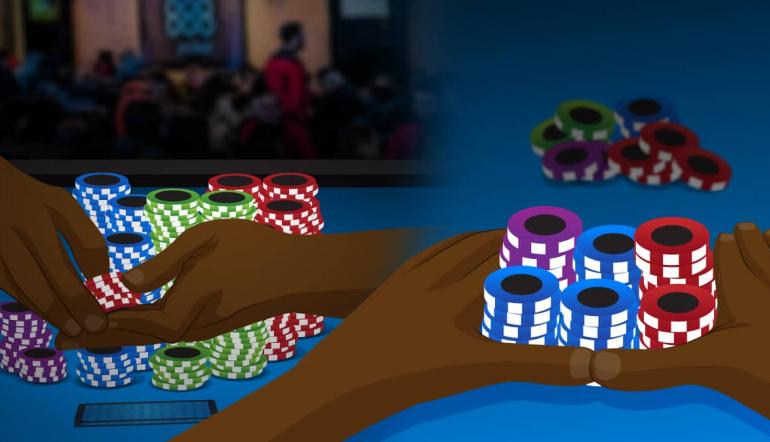Passive Poker
I help you categorize your opponents into their respective player types based on stats and tendencies. I also give some easy-to-use exploits against each.
- So, again, the tight passive player: Folds very often pre-flop. Constantly checks or calls on the flop. Habitually folds when he has the winning hand. Thinks he's a rock, but really he's a clod of dirt (as a poker player, of course).
- A tight passive player is a one-trick pony Hold'em player who has learned just enough about the game to understand the wisdom of being highly selective about what hands he chooses to see the flop with, but doesn't understand very much at all beyond that.
- Wagering Requirements. The wagering requirement is the minimum number of times you have to bet your bonus Tight Passive Poker Strategy amount to be able to cash out winnings from it. For instance, you may get a $25 no deposit bonus with a 30x wagering requirement.
Strategy (Part 1): The Study of Tactics in Poker Beating 6 Max No Limit Holdem by Sauce123 Spenda’s 5 Biggest Leaks of a Losing NL Player – Leak 1.
Listen to this podcast episode #289:
You MUST Understand Player Types
“The money available to a player winning long term comes from other players’ willingness to put money into the pot with bad hands that a perfect player would not play.”
– Ed Miller in his incredible book, The Course
This is exactly why we must understand player types and assign each of our opponents to one of them.
When you’re profiling your opponents, you’re looking for weaknesses. When you see those weaknesses, you know exactly how to play against them to earn their chips. You can also selectively target the weakest players who are most likely to give you their chips.
“Attack weakness, avoid strength.”
– Ed Miller in his incredible book, The Course
You’re looking to play more hands versus weak players and avoid hands versus strong players. Battling good players can kill your profits. We’re all playing this game, at least in part, to make money. Since it’s easier to make money versus the weak, that is who you MUST go after. The key to going after them is to understand and spot each of the weak players around the table.
You must become an active observer when you’re not involved in the hand:
- If a player just open-raised from the Hijack, and it’s the first hand he’s played in 3 orbits, he’s likely a tight player who only plays the best hands.
- Maybe another player makes her 4th limp in a row… she’s likely a Fish.
- Now a different player 3bets then triple-barrels down the streets with J8s after flopping TP. Wow! You found a loose and aggressive player.
Because you’re paying attention, you’re able to categorize each of these players and now you can use some basic exploits against each.
The 4 Common Poker Player Types
We use two different tendencies to put players into one of the 4 player types.
Tight versus Loose
A tight player plays few hands (VPIP < 20%), and a loose player plays a lot of hands (VPIP > 20%). 20% VPIP is just the cutoff percentage. Of course, players can be ultra-tight at 5% or ultra-loose at 95%.
Passive versus Aggressive
A passive player doesn’t raise preflop that often (PFR < 15%) and an aggressive player raises a lot (PFR > 15%). Again, 15% is just the cutoff with the ultra-passive player having a PFR of 1% and the mega-aggressive player at 45%.
Loose-Passive
LOOSE = Plays lots of hands; PASSIVE = prefer making checks and call; they love to see flops; they stay in way too long with weak hands and draws; #1 targets at the table; if they raise post-flop, WATCH OUT!
AKA: Fish or Calling Stations
Common VPIP/PFR Stats: 22/6, 28/5, 45/9 (Mention video in show notes detailing VPIP & PFR)
Color Coding: Green
Characteristic #1: Passively plays very wide & weak ranges. Not positionally aware.

Exploit: Play ranges that dominate theirs and isolate them (as limpers or in the blinds) whenever +EV.
Characteristics #2: Generally losing players.
Exploit: Target them and play as many hands as possible in +EV spots!
Loose-Aggressive
Loose Passive Poker
LOOSE = Plays lots of hands, AGGRESSIVE = prefers bets and raises; can be a high variance loser; they use the power of position yet they might not be that positionally aware when it comes to starting hands; capable of spewing chips in bad bluffing spots.
AKA: LAG, Donk or Maniac
Common VPIP/PFR Stats: 24/18, 36/24, 55/35
Color Coding: Orange
Characteristic #1: Too much aggression with weak ranges. Open-raises, iso-raises and calls too much preflop.
Exploit: Play with hands at the top of their range, and strive for IP play.
Characteristic #2: Constantly applies pressure.
Exploit: ALWAYS gauge how well the board interacts with their range. Be willing to call wider with 2nd and 3rd pair when they can be bluffing worse.
Tight-Passive
TIGHT = Plays mostly strong hands, PASSIVE = prefer checks and calls (but sometimes they’re aggressive with few calling hands); quick to fold post-flop; beware their bets and raises.
AKA: TP, Rock or Nit
Common VPIP/PFR Stats: 11/9, 11/2, 7/3
Color Coding: Red
Characteristic #1: Strong hand selection & positionally aware. Folds too often preflop and raises only strong hands.
Exploit: Play a wider but still strong range when IP. Call their raises with hands that play well post-flop and can crack big hands (good playability).

Characteristic #2: Doesn’t often fold to 3bets and 3bet = the nuts.
Exploit: 3bet and 4bet with the best hands to get value from his tight range.
Tight Passive Poker
Tight-Aggressive
TIGHT = Plays mostly strong hands, AGGRESSIVE = prefers bets and raises; can be winning regs; multi-tabler; quick to fold most marginal spots post-flop and when OOP.
Passive Income Poker
AKA: TAG, ABC or Reg
Passive Play Definition
Common VPIP/PFR Stats: 12/10, 18/13
Color Coding: Yellow
Characteristic #1: Plays multiple-tables, so they’re selective, patient and they choose the best starting hands (small & value intensive range).
Exploit: Play strong hands against them, but speculative hands can crack their strong ranges.
Characteristic #2: Quick to fold weaker pairs and draws because they see little value in these hands.
Exploit: Bet and raise to earn post-flop pots, make sure your size hits their “pain threshold” so often at 2/3 pot or more.
Here’s my challenge to you for this episode: While you’re playing your next session, set a timer to go off every 10 minutes. When it does, pick a table and think about each player there and describe all you know about them – player types, weaknesses, how to exploit, etc. This will train you to profile your opponents and it’s a great way to test that you’re paying attention.
Now it’s your turn to take action and Scooby-dooby-doo something positive for your poker game.

Support the Show
Tunisianking, Dayne Dice, Nathan Yamuder, Richard Cheason and Rosemont Tony picked up PokerTracker 4 (get it here to support the show), the best poker tracking software. I love it and use it everyday! In appreciation, I sent each of them a copy of my Smart HUD for PT4. With an ever-growing database of hands to study and all the helpful features, PT4 is the go-to software for serious poker players.
Passive Poker Player
Mark Fleming, Lois Thomas, Stephan Eck, Murry T., Massimo Gramegna, Stephen Diesner and Ole Engkrok bought the Smart HUD with a 1.5 hour webinar for PokerTracker 4. It’s the best online poker HUD in the business with every critical stat in the HUD and the 7 custom popups. This is what every online player needs to maximally exploit opponents.
The Poker Study Boot Camp Course was purchased by some seriously kaizen-minded poker peeps: Ram, Zeljko Arnautovic, Drew Dumpert, and Triumphnk. Thank you all so much. You’ve got your work cut out for you with this 29-day course, so good luck!
- Smart Poker Study Audiobook Excerpts - March 4, 2021
- I Am Your Poker Coach - February 16, 2021
- Counting Outs and Making Profitable Calls - February 4, 2021
Loose passive online poker players are the best types of players to play against. They're also the worst kind of poker player to be. A loose player will play too many hands, making their hands worse on average than a tighter player. This makes it hard for a loose player to win over the long run, because mathematically if you enter the pot with a worse hand than your opponent, you are less likely to win. Passive poker playesr tend to check and call most of the time. They only raise with their very best hands. This makes passive players easy to read, and makes it hard for them to be profitable. They also let their opponents draw to better hands without charging them enough to do so. For example, if you are playing against a loose passive player and you flop four to a flush, they are likely to check and let you draw to your flush without having to pay to do so. In addition, when you hit your flush they may even call a bet on the river.
The Worst Poker Players at the Table
Tight Passive Poker Player
When a player combines loose pre flop play with passive betting, you can see why they are some of the worst players at the table. The best way to spot loose passive poker players is to see which ones enter too many pots and almost never bet or raise. Online poker rooms, especially at the lower limits, are filled with loose passive players. Before continuing, make sure you understand what loose means when it comes to playing poker. Loose does not have a certain percentage attached to it - it's in comparison to the other players at the table. Here are two examples to illustrate a loose player at two completely different percentages of flops seen. In example number one, the average flop percentage is 30%. This means that on average, 30% of the players see each flop and each player sees on average 30% of the flops. A player who only plays 20% of the hands is tight, while a player who is seeing 40% of the flops is loose. In the second example, the average flop percentage is 18%. The player who is only seeing 14% of the flops is tight while the player seeing 25% of the flops is loose. Most of the time playing loose in comparison to the rest of the table is unprofitable. It can be profitable to loosen up a little bit in a very tight game. However, playing poker online you will rarely find a super tight table. Most online poker tables are completely opposite and are filled with lose players. Playing a passive overall poker style is never the path to becoming a winning poker player. Winning poker players are aggressive in most situations. They also know when to play a situation in a passive manner.
The best example of passive play being correct is when you are drawing to a flush or open end straight and the pot odds are giving you the correct price to call a bet. This type of play does not go against a normal aggressive strategy. It is simply smart poker and practiced by all winning players.
How to Beat Loose Passive Poker Players
The best way to beat loose passive poker players is to play the opposite of them, tight aggressive. They play too many poor hands so when you're playing tight, you will be entering the pot with a better hand than your opponent on average. This gives you great advantage before the flop.
This also lets you bet your best hands more aggressively pre flop because the passive player will be more likely to call a raise with a poor hand, especially if they have already limped into the pot before your turn to act. As a matter of fact, when you have position on a loose passive player who has limped before the flop you should almost always raise if you are going to play the hand. You're likely a favorite to win the hand, they will almost always call a standard raise and they are going to let you control the action after the flop. This is one of the absolute best situations that you will ever find at the poker table. Take advantage of it every chance you get.
Take Control of the Action
Once they are in a pot, they will let you control the action. If you want to build a bigger pot then bet, and they'll usually just call. When you want to keep the pot smaller, check and they will usually check with you. This is an area you need to be aware of in your opponents play as well as your own. An otherwise good poker player who finds himself or herself checking and calling more often than betting and raising after the flop has a leak in his or her game. Track your own play as well as that of your opponents to see if you are slipping into bad habits. One word of warning about playing a loose passive poker player. If they start betting and raising, then they almost always have a strong hand. For example, if they've been checking and calling, and a flush is completed on the river, and they fire out a bet, if they are truly a loose passive player, then they have almost always hit the flush. Be careful before assigning someone a loose passive tag. Make sure they aren't a better player than they appear. A good player will realize that you are good enough to fold to a bet like the one mentioned in the example and can use that against you. This is why you must always be paying attention to how the other players at the table are playing and taking notes for future playing sessions. If a loose passive player raises pre flop, especially from early position, you need to be careful. Loose passive players like to limp, not raise. They probably have a monster starting hand. If they raise, you re-raise, and then they raise again, they have AA or KK almost every time. In addition, the way they play after the flop in combination with them putting so much money in before the flop can make it difficult to make enough return if you are drawing to a set to beat them. The best bet is fold when they have a big hand and make it up when they revert to their normal passive play.

How to Be a Loose Passive Poker Player
In most cases there is a place for different kinds of play depending on the circumstances at the poker table. For example, if the table is all playing tight, you may want to loosen up your starting hand requirements. If the table is very looses, you probably want to tighten up your starting hand requirements. There are also instances, mentioned above, where you may play certain hands in a passive manner. But we can't think of a single situation where playing a loose passive style is profitable. Yes, you can probably win occasionally with a loose passive style, but in the long run you can not be a winning player.
Tighten Up
If you find yourself playing a loose passive style, the first thing you must do is tighten up your starting hand requirements. Less than 5% of online poker players play anywhere near too tight. The odds are that if you are reading this you should be playing a tighter pre flop strategy. This alone will improve your game over time.
Selective Aggression
The next thing you should do is work on being selectively aggressive. It is challenging to find the correct level of aggression when you are trying to learn the best way to play, but aggression is almost always better than playing passively. Many players combine working on both playing more aggressively and playing fewer hands by only playing hands pre flop that they can raise with. You will find as you become a better poker player that there are many hands that you should play without raising pre flop, but for new and learning players this is not a terrible strategy. You must also learn how to use position to help you decide how tight and aggressive you need to play. By being in position after the flop you have a better chance to control both the hand and the size of the pot.
There is no good reason to be a loose passive poker player, and you should find as many of them as possible to play against on a regular basis. One of the best things about playing online is that you have the chance to choose between many tables and many sites.
So if the table where you are seated doesn't have many loose passive players, find one that does. It will make it easier to win.